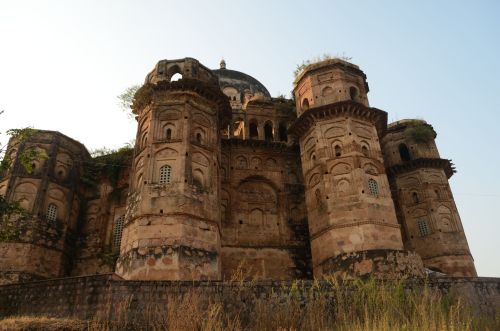The dust rose from the floor of the mud road , almost blinding our path, as we took a detour from the highway. It was a mausoleum amidst the dry fields that had drawn my attention. Earlier in the day, as I was leaving Khajuraho, Mamaji, the erudite scholar and my guide had handed over a small piece of paper in my hands. � You must see these places on the way to Orchha .Tell the driver, he will understand ,� he said as I scanned the paper, scrawled with a mix of English and Hindi words with some directions
Now , Mamaji was unlike any other guide I had met. We had spoken on hours relating to almost every aspect of the temples in Khajuraho , be it history, legends or tantrism. In impeccable English, he stuck to facts but his interpretations and pet theories would often be backed by historic claims as well. And as he walked with us, his 40 years of experience in tourism showed, but not his 67 years of age. So when Mamaji handed over the paper to me, I decided that I must stop over at the places he mentioned.
The first on the itinerary was a village called Mukarva in Chhatarpur which I was told would be almost 55 kms from Khajuraho. The village was home to the memorials built for Maharaja Chhatrasal , the fierce Bundeli warrior and his queen. An hour of driving around and the driver shook his head and said he has never heard of the village and refused to ask for directions. Finally we stopped by an unknown mausoleum on the highway and asked a couple of locals for directions. A couple of minutes later, we saw another tomb , followed by a third and then in the distance was a towering cenotaph . We parked the car and walked around the village, much to the amusement of the children who gathered around us. A couple of old women were sitting across each other outside their homes . The dogs seemed annoyed that we had interrupted their afternoon siesta. Then we saw a huge monument with a fort in the background.
The watchman showed us around, but insisted that we visit the queen�s cenotaph too. �There are so many fresco paintings inside, come I will show you� he said and got into the car with us as we drove a bit. And then we saw a lovely lake spread out in front of us circled by monuments � the centotaphs, the ruins of a fort and a palace in the distance which is now the Dubela museum. Suddenly an unknown , obscure village had turned into a historic spot.
The museum did attract a lot of tourists. The palace looked rather grand, but inside there was no light as we saw the sculptures, the weapons and other exhibits in virtual darkness. A lot of broken furniture was lying around .
Maharaja Chhatrapur would probably be happy that at least a town is named after him .The 17th century chieftain who had established his own kingdom had once ruled over the entire kingdom, with his capital at Panna . The diamond mines in his capital had ensured that his reign was rather prosperous. His claim to fame was of course that he had thwarted the Mughal emperor, Aurangazeb�s attempts to establish supremacy and collect tax. Apparently eight wars were fought between the Mughal forces and the Bundellas and the latter had been successful with their alliance with the Peshwa Baji Rao 11. . We heard more stories and legends and history sings panegyric verses and rich tributes to the king , but on land, his legacy is literally collecting just a lot of dust.
This story was published in my column, Inside Story on The Hindu, Metro Plus .
If you like my stories and my photographs and would like to travel with me, please join me on my Facebook page





No comments:
Post a Comment